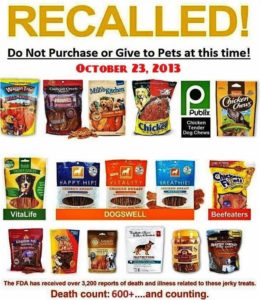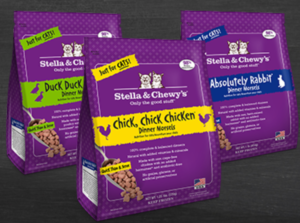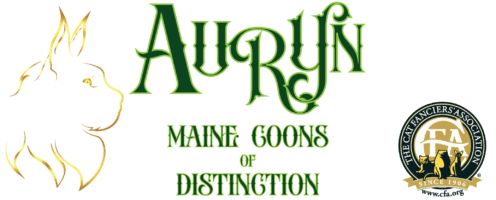What Should I Feed My AURYN Maine Coon?
Our objective as a conscientious breeder of Maine Coon Cats is to ensure that these beautiful, strong and majestic creatures remain that way for their entire lives. The absolute best way to do this is to feed them the way their bodies have been developed and evolved to consume their nutrition.
Felines are “obligate carnivores.” This means that the vast majority of their diet should be raw meat protein — plain and simple. But for some, not so easy to execute.
What is YOUR pet eating?

It would probably surprise you that approximately 95% of all the pet food manufactured today is controlled by a handful of conglomerate corporations. These companies have a singular objective to achieve: be profitable to their shareholders. It’s the fundamental equation of business: spend the least amount of money to produce a product that can be sold at a premium price for maximum profit. It has nothing to do with the health or welfare of your cat.
When you look at the numerous pet food recalls that have occurred over the past 20 years, you’d be surprised at what your standard pet food is made of and how it’s produced. Much of what is created consists of fillers, additives, preservatives and something known as “reconstituted meat” or “rendered meats” (aka Meat By-Products or Meat Slurry). Just “Google” the term and you’ll be horrified at what it actually is.
 Several years back, dogs and cats around the country began dying of mysterious causes. It turns out that a single distributer in the USA that supplies pet food manufacturers everywhere was shipping out an ingredient they acquired from China that was contaminated with toxic levels of melamine (yes the same thing used to make those “unbreakable” dishes you’ve seen everywhere). It caused the largest recall of pet food in U.S. history. But things didn’t end there.
Several years back, dogs and cats around the country began dying of mysterious causes. It turns out that a single distributer in the USA that supplies pet food manufacturers everywhere was shipping out an ingredient they acquired from China that was contaminated with toxic levels of melamine (yes the same thing used to make those “unbreakable” dishes you’ve seen everywhere). It caused the largest recall of pet food in U.S. history. But things didn’t end there.
The Pet Food Industry claims they are the most regulated industry in food manufacturing. The truth of the matter is that there are so many loopholes within the regulations issued by the USDA regarding pet food manufacturing, that the industry is almost completely self-regulated, able to bypass and wiggle through vague and inferior food standards that are meant to protect your pet.
The bottom line is simply that the big pet food manufacturing conglomerates will continue to find the cheapest ingredients and lowest costing manufacturing process to ensure their bottom-line continues to expand.
Pushback from the Veterinary Community
You would think that knowing how a feline eats would be something that your average veterinarian would champion. Sadly, this is not the case. In fact, both the AVMA (the American Medical Veterinary Association) and the AAHA (American Animal Hospital Association) have official policy statements discouraging the feeding of dogs and cats a raw food diet, citing the possibility of pathogenic contamination like listeria, salmonella and e-coli. So why are we suggesting something against the scientific community?

Let’s begin with basic feline anatomy. A cat’s digestive tract is a very caustic environment; the acidity of a cat’s stomach ranges from pH 1.1-1.9. It’s very difficult for these pathogens to survive in that level of acidity. To add to this, the digestive tract of a cat is extremely efficient, so it extracts its nutrition quickly and spends very little time inside a cat’s body due to the short length of its intestines; very little time to fester in the body. As much as this may seem clearly plain to a DVM, there are other influences guiding these decisions (which both of the above cited veterinary organizations will deny).
Veterinarians are given very little education in feline nutrition at vet schools. The courses they do receive are authored by the same conglomerates that formulate the pet foods and prescription diets you will find in veterinary offices all around the country! Conflict of interest? Perhaps. We are not conspiracy theorists, but it seems like common sense is lacking in this area.
These veterinary organizations will also cite that there is only anecdotal evidence regarding the results of feeding raw diets to cats and kittens. That may be the closest to the truth they have thus far exposed! Why? Because studies to prove these medical theories cost millions of dollars to fund, and without private benefactors to foot the bill on such studies, the ones holding the purse strings on funding are the same folks that have the most to lose from proving that raw feeding is best: the pet food industry!
“Pet FOOleD” The Documentary
The Truth About The Food You Buy For Your Pets…
 There is a real collaborative effort within the pet food industry that wants you to believe that they have your companion animals’ best interest at heart. They have weaved a web of partial truths, blurred regulations and slick advertising to convince you that the food you purchase at the grocery store, at the local or national pet store, or even at your own veterinary clinic, is safe, healthy and nutritious for your pets. Claims that the pet food industry are the most heavily regulated industry among food manufacturing are misleading and false. As a regular consumer, your only real education about your pet’s nutrition comes from the millions of dollars spent every year in advertising and colorful packaging.
There is a real collaborative effort within the pet food industry that wants you to believe that they have your companion animals’ best interest at heart. They have weaved a web of partial truths, blurred regulations and slick advertising to convince you that the food you purchase at the grocery store, at the local or national pet store, or even at your own veterinary clinic, is safe, healthy and nutritious for your pets. Claims that the pet food industry are the most heavily regulated industry among food manufacturing are misleading and false. As a regular consumer, your only real education about your pet’s nutrition comes from the millions of dollars spent every year in advertising and colorful packaging.
Recently, a new documentary film was released that uncovers the truth about the pet food industry in general, and how the pet-loving public has been duped into a sense of security by feeding their beloved pets the current regimen of kibble and canned foods on the market today. It’s entitled “Pet Fooled” and you can view a preview of it right here:
[arve url=”https://youtu.be/h3hMjQD5T9c” align=”center” /]© 2016 Gravitas Ventures, Dir.: Kohl Harrington, Prod.: Michael Fossett
This documentary is available to view on tubi© (valid as of February 2024) at this link: https://tubitv.com/movies/494913.
Please take time to view this very important film!
Kibble or Canned — What’s the Difference?
As mentioned above, felines are “obligate carnivores”; their bodies require meat proteins to sustain their health. However, just like human beings, cats have been given options by their unsuspecting caregivers to replace their natural diet with one that is (for lack of a better term) “fast food”. When you observe the increase in obesity, kidney and urinary tract diseases, liver failures, cancers, etc., it is clear that a “diet of convenience” is the root cause of the issues.
A cat’s dietary needs are very simple: raw meat with access to various amino acids their bodies cannot produce on their own (i.e Lysine, Taurine, Arginine, etc.). Cats also need water to sustain life correctly. When fed a species appropriate diet, the majority of their water comes from the meat they consume.
 When you look at the choices available to you on the grocery or pet shop shelf, your options are either kibble or canned (or some kind of hybrid packaging combination of the two). So why are these foods not appropriate when everyone is doing it? Why do the vast majority of Americans eat at places like McDonalds, Burger King, Taco Bell and the like? It’s simple: they are convenient and inexpensive. But looking at our society today, one can see the consequences of eating this way in the increased cases of morbid obesity, diabetes, cancer, skin disorders and many other health concerns that can be directly correlated to diet.
When you look at the choices available to you on the grocery or pet shop shelf, your options are either kibble or canned (or some kind of hybrid packaging combination of the two). So why are these foods not appropriate when everyone is doing it? Why do the vast majority of Americans eat at places like McDonalds, Burger King, Taco Bell and the like? It’s simple: they are convenient and inexpensive. But looking at our society today, one can see the consequences of eating this way in the increased cases of morbid obesity, diabetes, cancer, skin disorders and many other health concerns that can be directly correlated to diet.
Kibble is basically junk food for cats (think on the same level as Twinkies©, Doughnuts, candy bars, etc. for humans). It’s made from some form of meat protein with reconstituted meat (but not always!), grains, vegetables, fillers, salt, flavoring, preservatives and other hard-to-pronounce additives. In many cases, this food is supplemented with plant proteins, which is not correctly digested by a cat’s body. This form of food is compressed into bite-sized shapes and passed through several stages of cooking at high temperatures. This breaks down the protein chains that a cat needs to rebuild muscle tissue and defend itself from diseases. This process also extracts the water in the mixture thereby rendering the food dry and forcing the cat to find another source of water.
Canned cat food is ultimately an exercise in the “mystery meat” games (we’re now moving up to the realm of “fast food” for cats, not unlike McDonalds©, Dominos© Pizza, Taco Bell©). Some canned foods are barely acceptable, especially with the addition of gravies packed with high levels of carbohydrates and preservatives; a cats’ body won’t know what hit them.
We want to share with you a true (but graphic) story of what we experienced with our own cats.
Transitions and a Stinky Litter Box
When Nemo first came into our lives, we had a tough time deciding how we wanted him fed. We had had rescue cats before and it seemed that they developed health issues based on what we were feeding them. We had to change their diets several times and at their advanced age, it was tough to find food for them that they would eat. But whether is was high-priced brands or prescription diets, it was always made in kibble form. Neither of our two rescues wanted anything to do with canned food. And we were not educated enough to even consider a raw food diet.
One of the first things we noticed about Nemo was that his bowel movements were caustically aromatic. We first attributed it to the stress of moving across the country to a new home. The consistency of his feces was also cause for concern because our veterinarian suggested that his body wasn’t digesting his food properly. Nemo had been raised with a combination of kibble and canned so we wanted to be sure that he got the best food out there.
We began to research the feline diet and something kept sticking out: raw! After reading the evidence pro and con, it was clear to us that the pros had the huge advantage. The trick was to transition Nemo into this species appropriate diet, without causing added stress to our aging rescue kitty, who would only eat kibble.
After we lost our rescue boy, we decided to go 100% raw in the house. It was plainly evident though that Nemo was “addicted” to the kibble that we had been feeding him. Although we had removed the kibble from the feeding areas, Nemo would find the hidden bags of it and drag them under our bed where he would proceed to tear them open and help himself. We had to dispose of all traces of kibble from that point forward.

Stella & Chewy’s Complete Frozen Dinner Morsels
Once Nemo was weened off the kibble and canned food we had been feeding him and was consistently eating a 100% raw diet, we noticed two things very rapidly. First, his bowel movements were much better in consistency and had virtually no smell to it at all! Second, and perhaps more importantly, he displayed much more energy and his coat began to shine better than ever (one of the many benefits of feeding a cat a species appropriate diet).
When we acquired our female Georgina, she also had smelly feces, to the point of clearing the room of all human occupants! Since she was a younger kitten than Nemo, it was much easier to transition her to the raw diet, which she took to rapidly. Within a week, we no longer had issues with that nasty smelling litter box. As it turns out, in researching this phenomenon, cats as predators in the wild evolved to mask their waste eliminations in order to protect themselves from other predators or potential prey who might pick up their scent. The act of covering it (like in the litter box) also helped to camouflage their presence in the wild.
One ADDITIONAL benefit that thoroughly surprised us was that neither Nemo or Georgina was hacking up furballs…at all! These are LONG-HAIRED cats and they are constantly grooming themselves! Shouldn’t we expect that from time to time? The truth is that when your cat is fed the way his/her body evolved, the regurgitation of hair that seems typical in most housecats actully didn’t happen becuase they were no longer suffering from gastric difficulties related to inappropriate cat food!
Amazing how Mother Nature has developed this species, isn’t it!?
Nutrition and Health Au Naturale
Your AURYN Maine Coon has been fed a consistent diet of raw “obligate carnivore” food: Chicken, Duck, Turkey, Emu, and Rabbit, mixed in with a little Venison, Lamb and Beef from time to time. It is our belief that if you continue to feed them in this manner, your kitten will grow and develop into strong, healthy felines with a long life to look forward to. As mentioned above, you may find hesitation from your own veterinarian on feeding your cats a raw diet, and may even be admonished to stop entirely.
We can only provide you with our own “anecdotal” evidence: our cats are healthy, happy, energetic, have healthy coats and they show tremendous strength, agility and development with very few health issues. And we can back up our claims with the clean bill of health each cat receives from our world-class veterinary staff at Cottonwood Animal Hospital.
Does this mean that our cats can’t become sick? Of course it doesn’t. They are still subjected to the same nasty viruses and bacteria as any other cats out there. But we believe that feeding them the highest quality of food available gives an AURYN Maine Coon kitten or cat the best advantage to live a long healthy life, compared to cats and kittens that are fed a typical commercially available pet food.
All we can do as your kitten’s breeder is encourage you to continue to supply your carnivore with the kind of food their bodies were designed to digest. We cannot force you to follow our lead, but we can assure you that you will find a much happier cat with less health issues in the future if you commit to continuing your AURYN Maine Coon’s established diet in your home. Your AURYN cat may easily take to a different, more convenient and inexpensive diet. But our experience shows us that you will be much happier with the results if you stay the course of your Maine Coon’s diet as we’ve spelled it out for you.
We strongly encourage you to follow Dr. Karen Shaw Becker regarding diet and other important health and veterinary issues. Her website is https://www.barkandwhiskers.com/ and you can also see her You Tube channel at: https://www.youtube.com/@DrBecker
For more information about feeding your cat a raw “species appropriate” diet, refer to the research you’ll find at Feline Nutrition.org or Cat Info.org.


